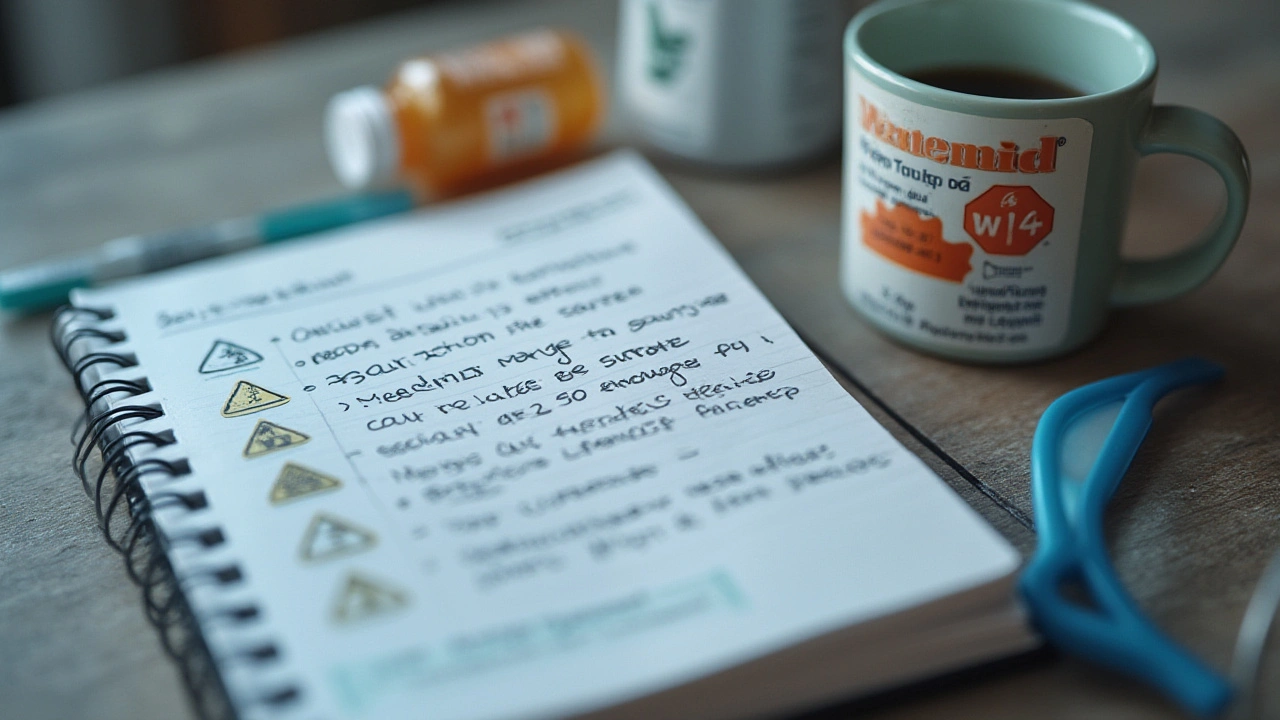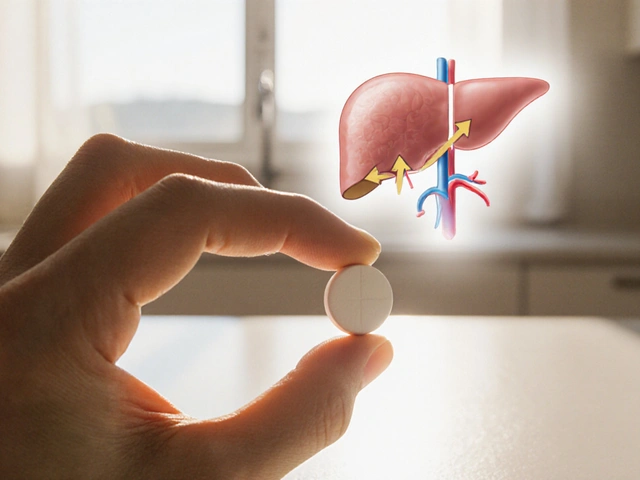
If you’ve ever hobbled through the day because a single big toe was throbbing like a cartoon thumb after a hammer blow, you know gout isn’t just a punchline in old British novels. It’s a real, raw pain—one millions fight every year. Among the quirky pills sitting on pharmacy shelves for it? Benemid. Sounds almost friendly, right? Like your next-door neighbor who always has spare batteries. But Benemid packs a complicated punch when it comes to treating gout and managing uric acid. There are some things prospective patients desperately wish they’d known before their first prescription. Ready for the nitty-gritty on Benemid?
What Is Benemid and How Does It Work?
Benemid is the brand name for something called probenecid. It’s easy to lump it together with the pile of painkillers and anti-inflammatories usually handed out for gout, but Benemid doesn’t fit that mold at all. It’s not there to squash pain. Rather, it gets right to the chemical heart of gout attacks: uric acid. If you’re like me, you probably didn’t think much about uric acid before—if at all. It sounds harmless, maybe like something you’d find in a lemon cleaner. But when too much of it sloshes around in your blood, that’s when trouble starts: uric acid forms crystals that end up in your joints, causing those classic gout flares.
Here’s where Benemid earns its keep. Its superpower is telling your kidneys to get off their lazy metaphoric butts and kick more uric acid out of your system. It’s what is known as a "uricosuric" agent. Instead of helping you cope with a flare, it works behind the scenes, lowering that constant sea of uric acid over time. That means fewer attacks—if you catch it early and take it consistently.
Now, before you think this pill is the solution everyone’s been waiting for, let’s get real. Benemid only works if your kidneys still have the get-up-and-go to do their job. If they’re not filtering things the way they should (say, due to chronic kidney disease), Benemid isn’t going to help much. And, oddly enough, it can make things worse for people with certain kinds of kidney stones, since it shuttles more uric acid into urine—and that can lead to new stones forming.
Doctors have used Benemid for decades—since the early 1950s, in fact. It was actually one of the first drugs developed specifically to treat chronic gout. Back when it first came out, it was even a go-to for boosting the levels of antibiotics like penicillin in the blood. Modern medicine has found other ways for that, but Benemid’s place as a uric acid warrior remains pretty unique.
| Year Approved | Main Use | Average Dosage per Day | Key Patient Restriction |
|---|---|---|---|
| 1951 | Gout Management | 500mg–2g | Kidney Disease |
So, who actually gets a prescription for Benemid these days? Doctors might consider it when allopurinol or febuxostat—the other common uric acid drugs—don’t quite do the trick, or if a patient’s body doesn’t tolerate those well. Not everyone is a good candidate, which is why that pre-prescription chat and a few kidney tests are pretty much non-negotiable.
If you’re curious how fast it works, don’t get your hopes up for instant relief. Most updates in uric acid levels creep in over weeks. Some folks even find gout bumps (called "tophi") in their fingers or toes shrink with regular use—but we’re talking several months to see changes like that.
It might sound like a quiet backstage player, but Benemid has a starring role in certain tough gout cases. And, while it’s not first in line for most patients, knowing there’s still an option for lowering uric acid when others flounder is a quiet relief. My dad, for instance, found Benemid helped just enough that the term “toe pain” wasn’t synonymous with every winter holiday dinner.

Possible Side Effects and Drug Interactions
Reading the fine print on a new medication always feels like a game of “what’s the worst that could happen?” Benemid’s list isn’t the longest out there, but it’s not something you want to ignore. Since the drug signals your kidneys to start dumping extra uric acid, the most common downside is—you guessed it—potential kidney stones. If you’ve ever tried to pass a kidney stone, even reading those words might make you shiver. Like being stabbed in the back, but from the inside.
For Benemid users, the trick is to drink a lot of fluids—think two or three liters a day (basically, picture hauling around a big water bottle everywhere you go). Staying well hydrated keeps the urine diluted, less likely to let crystals form, and it just gives your kidneys a smoother ride.
Other side effects aren’t as dramatic but still matter. Some people get mild rashes, headaches, dizziness, or stomach upset. A few unlucky folks find themselves with fever or, rarely, even more serious allergic reactions. There’s also a faint risk of certain types of anemia, but that’s usually with much higher doses than doctors use for gout today.
Here’s a helpful chart summarizing side effect risks from real-world patient data collected by a 2022 European rheumatology survey:
| Side Effect | Estimated % of Patients |
|---|---|
| Kidney Stones | 11% |
| Stomach Upset/Nausea | 8% |
| Skin Rash | 5% |
| Headache | 3% |
| Allergic Reaction | <1% |
The thing people forget is drug interactions: Benemid messes with the way your body handles more meds than most people realize. For starters, it boosts the effect of a few antibiotics, especially penicillin and some cephalosporins, by stopping your kidneys from tossing them out too soon. That’s great when doctors want it—but risky if you’re upping the dose accidentally. Big red flag? Don’t take Benemid with high-dose aspirin. Low-dose aspirin (like those tiny, heart-health ones) is okay, but regular painkiller doses make Benemid stop working and can raise your risk for kidney problems. That’s a gotcha a surprising number of people miss.
If you take drugs for diabetes, blood thinners, seizure prevention, or transplant rejection, run every one by your doctor. The pharmacy computer might miss a few subtle ones—better to be safe. And if you happen to take a handful of meds each morning, stick with a schedule that spaces Benemid apart. Spacing it about two hours from other important pills can sometimes help dodge absorption issues or unwanted overlaps.
So, basically, Benemid is a bit more high-maintenance than most over-the-counter packets. It’s absolutely not the sort of thing to add to your regimen quietly, even if you snag an old bottle from a parent’s medicine stash (yeah, people do that). Always double-check with your doctor and pharmacist, and keep a written list of all your meds, herbal supplements, and regular vitamins. Trust me, it prevents a million headaches down the line—sometimes literally, if interactions would have led to one.
For those who have kids like Darian floating around the house, always keep Benemid up high and out of sight. Curious little hands find bottles faster than you can say, “those are not jellybeans.” And it takes only a small amount of probenecid to cause problems in young children—so this is not one to leave on the bathroom counter.

Real-World Tips for Safe and Effective Use
Benemid might look like just another white pill, but managing it day-to-day can be surprisingly tricky. Just from watching my own family navigate the dosing routine, I know how small mix-ups can spiral fast. Here are some hard-learned lessons and proven tips:
- Start low, go slow: Doctors usually start patients on a lower dose, often 250–500mg twice daily, and inch up from there only after urine tests and bloodwork give the all-clear.
- Never skip hydration: This is the rule that makes or breaks Benemid success. A huge tumbler at breakfast, water with every meal, and an extra glass before bed. Set reminders if you’re forgetful (I stick sticky notes everywhere—works like a charm).
- Stick to a meal schedule: Taking Benemid with food or immediately after helps cut the risk of nausea and stomach pain. Small snacks do the trick—I’m partial to a banana or plain yogurt—just something bland that’s gentle on the stomach.
- Watch for sudden pain: If you feel sharp pain in your lower back or groin, or the pain is different from your usual gout, let your doctor know right away. It could mean a kidney stone is forming.
- Create a medicine journal: One notebook, every dose logged. Note if you miss a pill, feel off, spot anything weird, or notice swelling or rashes. Makes the next doctor appointment way easier, and if Darian wants to doodle on the side, maybe it’ll turn into a cherished (and surprisingly useful) family artifact.
- Don’t be afraid to ask for bloodwork: Regular uric acid checks help tailor doses and spot any early warning signs. At least every six months, some folks might need them more often at first.
- Know your triggers: Even on Benemid, certain foods (red meat, shellfish, some sweetened drinks) still matter. It’s not a free pass, but if that slice of bacon sneaks onto your plate, life moves on—just don’t make it a daily guest.
Families can pitch in, whether it’s helping keep the water cooler filled or nudging you to take your doses. If you ever struggle remembering pills in the shuffle of parenting (hello, school runs and soccer snacks), try pill boxes with alarms. Technology’s your friend here, not your enemy.
One thing you might not expect: Benemid sometimes gets used alongside other gout drugs, like allopurinol, if uric acid just isn’t budging. That combo can be more effective than either drug alone—but it comes with its own risks, so those on double-treatment need even closer follow-ups.
And if you’re starting Benemid right after a gout attack? Be aware that, weirdly enough, reducing uric acid suddenly can sometimes trigger yet another attack. Doctors often keep people on anti-inflammatory medicines like colchicine or NSAIDs for the first few weeks to prevent this. It’s a quirk, but worth preparing for—stock those ice packs and gentle socks, just in case.
Pregnant or breastfeeding? There isn’t a ton of data, but Benemid generally isn’t tested much in these situations, so most docs avoid it. If you end up in that tiny group where it’s considered essential, you’ll need extra careful monitoring.
Sticking to Benemid feels like balancing a wobbly tray—rewarding, if done carefully, and not impossible, but not something to do half-asleep. Every little step, from hydrating to meal timing to updating your medicine list, stacks the deck for you and your family. And as the years go by, with each holiday where everyone actually gets to feast without a cloud of foot pain hanging overhead, you’ll remember exactly why the routine is worth it.
Emily Rose
Benemid saved my dad’s life-literally. He was on allopurinol for years, but his uric acid kept creeping up. We thought he’d be stuck with monthly flares forever. Then his rheumatologist switched him to Benemid and told him to drink a gallon of water a day. Sounds crazy, right? But within three months, his tophi started shrinking. He still takes it, still hydrates like a camel in the desert, and now he plays golf without wincing every time he swings. If you’re skeptical, just give it time and water. No magic pill, but it works if you do the work.
Also-DON’T take it with ibuprofen. I learned that the hard way. My dad ended up in the ER with kidney spasms. Don’t be him.
Benedict Dy
The article is factually accurate but dangerously oversimplified. Probenecid is not a first-line agent for gout management per the 2020 ACR guidelines. Its use is reserved for patients with underexcretion phenotypes confirmed by 24-hour urine uric acid testing. Most patients are overproducers, not underexcretors-meaning Benemid is ineffective in ~70% of cases. The author’s anecdotal framing misleads readers into believing this is a universal solution. This is not medical advice; it’s anecdotal marketing dressed as patient education.
Emily Nesbit
There’s a grammatical error on page two: ‘It’s what is known as a "uricosuric" agent.’ Should be ‘It’s what is known as a uricosuric agent.’ No quotation marks needed around the term when it’s used descriptively, not as a direct quote. Also, ‘shuttles more uric acid into urine’-‘shuttles’ is a metaphor, but it’s imprecise. ‘Increases renal excretion of uric acid’ is the correct terminology. This isn’t just nitpicking-it’s about clarity in medical communication.
John Power
Hey everyone-just wanted to say this post is one of the clearest, most human takes on Benemid I’ve seen. I’ve been on it for 4 years now, and honestly? The hydration thing is everything. I carry a 32oz bottle everywhere. I even have one by my bed. I used to forget, then I started setting alarms on my phone labeled ‘WATER NOW’ and it changed everything.
Also, I started taking it with a banana. No more stomach issues. And yeah, I still get flares sometimes, but way fewer. If you’re scared to start it, just talk to your doc. It’s not scary once you get the rhythm. You got this 💪
Richard Elias
Benemid? Man I tried that thing. Worst decision ever. My kidneys felt like they were fulla gravel. I drank like 3 gallons a day like they said but still got a stone. Now I just take colchicine and eat chicken. No more pain. Why do docs even prescribe this? I think they just wanna feel like they’re doing something. Honestly, if you’re not rich or a scientist, just avoid it. It’s a waste of time and cash.
Also, probenecid? Sounds like a brand of energy drink.
Scott McKenzie
Big thank you to the author for writing this. I’ve been on Benemid for 2 years and honestly? I almost quit because I thought it wasn’t working. Then I realized I wasn’t drinking enough. Now I have a water tracker app and I’m down from 4 flares a year to 1. Sometimes zero.
Also-don’t ignore the pill box with alarms. I got one with colored sections and it’s a game-changer. And yes, I still keep it out of my kid’s reach. He’s 3 and thinks all pills are candy. Learned that the hard way. 😅
Jeremy Mattocks
Let me tell you something about Benemid that nobody talks about: it’s not just about uric acid. It’s about discipline. You’re not just taking a pill-you’re signing up for a lifestyle overhaul. You have to track your water intake, your food, your meds, your symptoms. You have to be the CEO of your own body. And yeah, that’s exhausting. But here’s the thing-it’s worth it. I used to cancel plans because my toe was swollen. Now I hike on weekends. I started taking it in 2020. It took six months before I noticed a difference. Six months of drinking water like it was my job. But now? I don’t even think about it anymore. It’s just part of me. If you’re thinking about starting it, don’t look for quick fixes. Look for consistency. And if you slip up? Start again tomorrow. No guilt. Just water. Just discipline. Just you.
Also, I take mine after breakfast with a slice of toast. Small things matter.
Paul Baker
Benemid is cool but i think people forget it was origionally for penicillin not gout lol
also dont forget to drink water like ur in the desert
also my dog drank my pill once and he was fine so maybe its not that bad? 😅
Zack Harmon
THIS IS A TRAP. BENEMID IS A CORP TOOL TO KEEP YOU ON DRUGS FOREVER. THEY WANT YOU TO THINK YOU NEED IT. THEY WANT YOU TO DRINK WATER ALL DAY. THEY WANT YOU TO BUY PILL BOXES AND WATER BOTTLES AND JOURNAL YOUR LIFE. BUT WHAT IF THE REAL PROBLEM IS YOUR DIET? WHAT IF YOU JUST NEED TO STOP EATING BACON? WHAT IF YOU JUST NEED TO STOP DRINKING SODA? THEY DON’T WANT YOU TO KNOW THAT. THEY WANT YOU TO BE DEPENDENT. BENEMID IS A SCAM. I’VE SEEN THE DOCUMENTS. THE PHARMA COMPANIES MADE THIS SO YOU’LL NEVER BE FREE. I’M NOT JUST A PATIENT-I’M A WITNESS.
Jeremy S.
Works for some, not for others. Don’t stress if it doesn’t click. There are other options.
Jill Ann Hays
The entire premise of this article is rooted in a metaphysical fallacy-the assumption that disease is a problem to be solved rather than a natural consequence of biological entropy. Benemid does not cure gout; it merely delays the inevitable oscillation between homeostasis and chaos. The human body is not a machine to be calibrated. It is a dynamic system in perpetual tension. To believe that a pill can restore balance is to misunderstand the very nature of existence. Your kidneys are not pumps. They are witnesses. And you? You are merely a temporary vessel.
Also, hydration is irrelevant. The soul does not require water. It requires awareness.
Mike Rothschild
Benemid isn’t glamorous, but it’s real. I’ve been on it since 2018. My doc told me to start at 250mg and go slow. I did. I drank water. I logged everything. I didn’t rush. I didn’t expect miracles. It took 8 months to see real change. But now? I don’t fear holidays. I don’t dread shoes. I don’t need to cancel plans. It’s not a cure. It’s a tool. And tools need care. Treat it like a car-you don’t just fill the tank and forget it. You check the oil. You keep it clean. You maintain it. That’s all this is. Consistency beats intensity every time.
Ron Prince
Why are we letting these drug companies run our lives? Benemid? Sounds like something a socialist doctor would prescribe. Back in my day, we just ate less meat and drank tea. We didn’t need fancy pills. This is why America’s broken. We’re too lazy to change our habits. We want a pill for everything. Now we’re paying $300 a month for a drug that makes you pee more. What a joke. I’d rather just quit beer and steak. Simple. Free. American.
Sarah McCabe
Just moved from Ireland to the US and I was shocked how many people here know about Benemid 😅 I’ve been on it since 2021 and honestly? It’s been fine. I drink tea and water. I eat my veggies. I don’t stress. My Irish grandma would say: ‘If it ain’t broke, don’t fix it.’ But if it’s helping you? Go for it. Just don’t forget to laugh sometimes. And drink water. Always drink water 🌊
King Splinter
Look, I read this whole thing and I’m still not convinced. I mean, yeah, sure, it works for some people. But why is this even a thing? Why not just tell people to stop eating shrimp? Why do we need a $400 pill that makes you pee like a racehorse? This is capitalism in action. We’re being sold a solution to a problem we created by eating pizza and watching Netflix. The real treatment? Get off the couch. Eat a salad. Walk 10 minutes. But no, let’s just give people a pill and call it medicine. I’m not mad. I’m just disappointed.
Kristy Sanchez
Oh wow. Another ‘my dad’s toe pain disappeared’ story. How original. Did he also start meditating and buy a crystal water bottle? Did he post a TikTok about it? Look, Benemid doesn’t cure gout-it just masks the symptoms while you keep eating bacon and drinking beer. And now you’re proud of yourself for drinking water? Congrats. You’ve achieved the bare minimum of human survival. Meanwhile, the real issue-your lifestyle-is still intact. You’re not healing. You’re just delaying the inevitable collapse. And you call this progress? Pathetic.
Michael Friend
Benemid is a nightmare. I had a kidney stone that felt like a knife being twisted inside me. I was screaming in the ER. They told me it was from Benemid. I’ve been on it for two years. I trusted my doctor. I did everything right. And still-my body turned on me. Now I’m terrified to even look at a pill bottle. I don’t trust medicine anymore. I don’t trust doctors. I don’t trust myself. This isn’t treatment. This is a gamble with your organs. And I lost.
Jerrod Davis
It is imperative to underscore that the pharmacokinetic profile of probenecid necessitates a rigorous and individualized titration protocol, particularly in the context of concomitant administration of nonsteroidal anti-inflammatory agents. Furthermore, the potential for nephrolithiasis remains a clinically significant concern, warranting the implementation of prophylactic hydration regimens and routine renal function monitoring. The anecdotal framing presented herein, while emotionally resonant, lacks the methodological rigor required for evidence-based clinical decision-making. It is recommended that patients consult peer-reviewed literature and adhere strictly to guideline-directed therapy as outlined by the American College of Rheumatology.
Emily Rose
John Power-your comment about the banana? I’m stealing that. I’ve been taking mine on an empty stomach and I’ve been nauseous for weeks. Just tried it with yogurt this morning. No issues. Thank you. I owe you a coffee.
Also, @5076-your story broke my heart. I’m so sorry. You’re not alone. I’ve been there too. I cried after my first stone. But I kept going. And I still do. It’s not perfect, but it’s better. You deserve peace. Keep talking. Keep asking. You’re not weak for needing help.





Write a comment